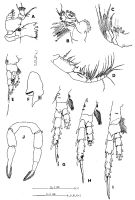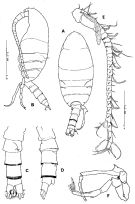|
|
 |
|
Calanoida ( Order ) |
|
|
|
Clausocalanoidea ( Superfamily ) |
|
|
|
Stephidae ( Family ) |
|
|
|
Stephos ( Genus ) |
|
|
| |
Stephos pacificus Ohtsuka & Hiromi, 1987 (F,M) | |
| | | | | | | Ref.: | | | Ohtsuka & Hiromi, 1987 (p.219, figs.F,M, gut contents); Chihara & Murano, 1997 (p.913, Pl.178,179: F,M); Bradford-Grieve, 1999 a (p.25, Table1: Rem.); S.Y. Moon & al., 2015 (p.31: Rem.) |  issued from : S. Ohtsuka & J. Hiromi in Publ. Seto Mar. Biol. Lab., 1987, 32 (4/6). [p.220, Fig.1]. Female (from Tanabe Bay, Japan): A, habitus (dorsal); B, idem, with spermatophore (lateral left side); C, urosome with spermatophore (lateral left side); D, A1; E, A2. Nota: head and 1st thoracic segment separated, 4th and 5th partially fused. Urosome 4-segmented. Genital segment both sides with a curved row of minute spinules. 2nd and 3rd urosomal segments furnished with dense rows of spinules along distal margin. Anal segment small. Spermatophore attached to genital segment, susage-shaped, reacing beyond caudal rami. Caudal ramus slightly longer than broad, with hairs along inner margin and a minute setule near outer distal margin. A1 24-segmented (1st and 2nd segments partly fused), 1st to 10 th (except for 4th segment) with minute spinules, 12th to 23rd segments each with a small lamellar plate. A2 with exopod 6-segmented, endopod 2-segmented.
|
 issued from : S. Ohtsuka & J. Hiromi in Publ. Seto Mar. Biol. Lab., 1987, 32 (4/6). [p.221, Fig.2]. Female: A, Md; B, Mx1; C, Mx2; D, Mxp; E, P1 (anterior); F, endopod of P1; G, P2 (posterior); H, P3 (anterior); I, P4 (posterior); J, P5 (posterior). Md basipod bearing 4 setae of unequal lengths along inner margin; endopod bearing 4 subterminal setae on proximal segment and 11 setae on apical segment; exopod 5-segmented. Mx1 gnathobase (1st inner lobe) with 6 spines and 7 setae; 2nd and 3rd inner lobes bearing 3 and 4 setae, respectively; basipod 2 with a row of minute spinules longitudinally and 5 setae on inner distal end; exopod with 2 rows of fine spinules and 11 plumose setae distally; endopod 2-segmented, proximal segment bearing 9 setae and apical segment with 7 setae. Mx2: 1st to 6th inner lobes bearing 6, 3, 3, 3, 4 and 1 setae, respectively; 4th and 5th inner lobes each with stout spiniform seta.
|
 issued from : S. Ohtsuka & J. Hiromi in Publ. Seto Mar. Biol. Lab., 1987, 32 (4/6). [p.223, Fig.3]. Male: A, habitus (dorsal); B, idem (lateral left side); C, urosome (ventral); D, idem (lateral left side); E, A1; F, P5 (anterior). Posterolateral corners of prosome slightly asymmetrical due to an extension of left distal corner. Urosome 5-segmented; 1st urosomal segment asymmetrical, swollen on left side; 2nd urosomal segment produced posteroventrally into short process, and furnished with a row of spinules along dorso-distal margin. A1 with a very large aesthetasc present on 1st segment
| | | | | Compl. Ref.: | | | Ohtsuka & al., 2008 (p.115, Table 4, Rem.: in Kobe Harbor) | | | | NZ: | 1 | | |
|
Distribution map of Stephos pacificus by geographical zones
|
| | | | Loc: | | | Japan (Tanabe Bay) | | | | N: | 1 | | | | Lg.: | | | (559) F: 0,73; M: 0,62; {F: 0,73; M: 0,62} | | | | Rem.: | Depth: 6-7 m. epi-hyperbenthic.
According to Ohtsuka & Hiromi (1987, p.225) the most characteristic feature of the feeding habits is that epibenthic organisms such as naked ciliates, nematodes and pennate diatoms were fed together with pelagic organisms (centric diatoms). The main foods were diatoms and naked ciliates, crustacean fragments and copepod nauplii occurred in less than 40 %; other organisms such as coelenterates, nematodes, rotifers, dinoflagellates were less frequently found; unidentified remains were also detected in all the guts. The authors observed living individuals swimming in dishes with the flat bottom during daytime; the copepods swam within 4 mm above the bottom and rarely moved upwards. The copepods were continuously swimming very fast using the antennae and mandibular palps usually with the left side of the bodies parallel to the bottom.
After Bradford-Grieve (1999 a, p.25) this species belongs to type IV (see Genus Stephos). | | | Last update : 25/12/2015 | |
|
|
 Any use of this site for a publication will be mentioned with the following reference : Any use of this site for a publication will be mentioned with the following reference :
Razouls C., Desreumaux N., Kouwenberg J. and de Bovée F., 2005-2025. - Biodiversity of Marine Planktonic Copepods (morphology, geographical distribution and biological data). Sorbonne University, CNRS. Available at http://copepodes.obs-banyuls.fr/en [Accessed December 29, 2025] © copyright 2005-2025 Sorbonne University, CNRS
|
|
 |
 |






